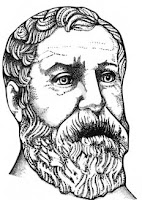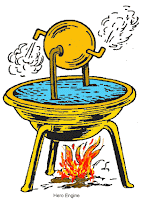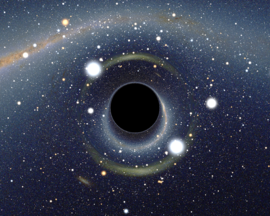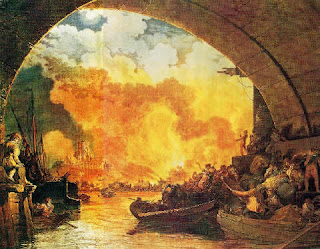The Great Fire of Rome erupted on the night of July 18 to July 19, 64. The fire started at the southeastern end of the Circus Maximus,Rome's mammoth chariot stadium. in shops selling flammable goods.
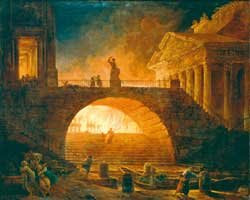
In a city of two million, there was nothing unusual about such a fire -- the sweltering summer heat kindled conflagrations around Rome on a regular basis, particularly in the slums that covered much of the city. Yet this was no ordinary fire. The flames raged for six days before coming under control; then the fire reignited and burned for another three.
When the smoke cleared, 10 of Rome's 14 districts were in ruin. The 800-year-old Temple of Jupiter Stator and the Atrium Vestae, the hearth of the Vestal Virgins, were gone. Two thirds of Rome had been destroyed.
According to Tacitus { aristocrat and historian } , upon hearing news of the fire, Nero rushed back to Rome to organize a relief effort, which he paid for from his own funds.
After the fire, Nero opened his palaces to provide shelter for the homeless, and arranged for food supplies to be delivered in order to prevent starvation among the survivors.In the wake of the fire, he made a new urban development plan. Houses after the fire were spaced out, built in brick, and faced by porticos on wide roads.
Nero also built a new palace complex known as the Domus Aurea in an area cleared by the fire. This was a 300 acre palatial complex that featured the Colossus Neronis, a 37-meter-high bronze statue of Nero placed just outside of the entrance. To find the necessary funds for the reconstruction, tributes were imposed on the provinces of the empire.

HISTORICAL VIEWS
The varying historical accounts of the fire come from three secondary sources- Cassius Dio, Suetonius and Tacitus. The primary accounts, which possibly included histories written by Fabius Rusticus, Cluvius Rufus and Pliny the Elder, did not survive.
These primary accounts are described as contradictory and gross exaggerations.At least four separate stories circulated regarding Nero and fire:
Cassius Dio:
Motivated by a desire to destroy the city, Nero secretly sent out men pretending to be drunk to set fire to the city. Nero watched from his palace on the Palatine Hill singing and playing the lyre.
Suetonius:
Motivated by an insane whim, Nero quite openly sent out men to set fire to the city. Nero watched from the Tower of Maecenas on the Esquiline Hill singing and playing the lyre.
Tacitus 1:
Nero sent out men to set fire to the city. Nero sang and played his lyre from a private stage.
Tacitus 2:
The fire was an accident. Nero was in Antium.
Tacitus was a member of this Roman elite, and whether there is a bias in his writing is difficult to know. Indeed, Tacitus was still a boy of 9 at the time of the fire, and he would have been a young teenager in 68 A.D., when Nero died.
WAS NERO THE ARSONIST ??

NERO has always been labelled as a tyrant and an eccentric, and the long list of his evil deeds , as the murder of his wife and mother, certainly gave grounds for suspicion.
Rumours are that one of the grandest plans of Nero was to tear down a third of Rome so that he could build an elaborate series of palaces that would be known as Neropolis. The senate, however, objected ardently to this proposal.
The emperor's passion for theatre fed rumours that he wanted an opportunity to sing a poem of about the burning of Troy.
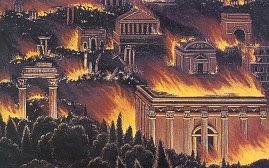
IDEAL SUSPECTS
It was an easy matter to blame the CHRISTIANS for the blaze.Small in number and poor, they were considered as foreigners by the citizens of Rome. The fire gave Nero the perfect opportunity to begin a systemic persecution of the christians in the hope that he could placate the anger of the people and turn opinion in his favour.
Countless arrests were made and many met gruesome deaths- fed to lions during gladiator matches, crucified and used as human torches...
Yet there is evidence that, in 64 A.D., many Roman Christians believed in prophecies predicting that Rome would soon be destroyed by fire. Perhaps the fire was set off by someone hoping to make the prediction come true.
Today, 20 centuries later, the mystery remains!
